Would someone have experience with driving a pair of LM3886 Overture Power Amplifiers in BTL with up to 100 KHz sine wave?
My parameters:
- Frequency band of interest: 20KHz to 100 KHz, sine wave
- Load is pure capacitive, 10-20 Ohm, 5000 pF
- Power delivery to load: Up to 50 watts RMS
- Amplifier Configuration: Bridge Tied Load
- THD / noise, even up to 5%, not a concern
- Power: Unregulated +/-35 Volts 5+5 Amperes, 10000 uF reservoir capacitor on each rail
Found a useful whitepaper on BTL with LM3886. However, the operating band for this paper is 20Hz-20KHz.
Starting with the schematic from here:

Of course, input / output / feedback part values shown would need to change for my frequency band of interest, but my analog-fu is a bit rusty circa 1988, so some brushing up to be done.
My questions:
- Will this work at all? (I don't see why not, but found no useful information found)
- Any suggestion on a different single-chip power amp to use instead?
- What is the gain I should design for?
- More immediate interest: What input Vpp range is needed?
- What do I need to take care of in terms of feedback / compensation and stability management
- Info found so far is for audio frequency range, little mention of high frequencies
- Found a discussion about oscillation at high frequencies (50KHz+) due to electrolytic caps.
- No info found about driving capacitive load, as audio = inductive loads, typically.
- How do I get an essentially flat response for 20-100 KHz?
- For the power supply:
- Recommendations between single and dual bridge
- Is the 5 + 5 ampere calculation good, with reasonable headroom?
- Is there a switching power supply alternative that might save cost / reduce heat?
- Anything else critical to address even at experimental stage (One-off DIY, isn't going to production)
Any other inputs / help / advice gratefully accepted!